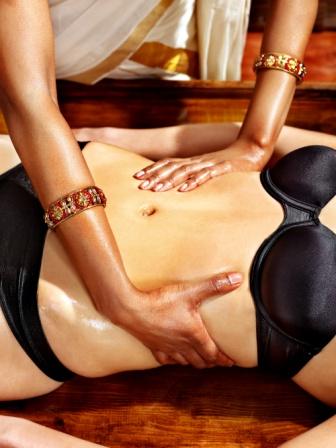Nabhi Lepa Treatment Method Procedure, Benefits
Article by Dr Raghuram Y.S. MD (Ay) and Dr Manasa, BAMS
Nabhi Lepa is an Ayurvedic treatment method where, herbs are made into paste and applied over the umbilical region. The paste is retained on the navel area for 10 – 30 minutes, or even longer in some cases.
Table of Contents
Nabhi lepa method
Method of Nabhi Lepa
In this the paste of medicinal herbs especially those which rectify metabolism (deepana-pachana herbs) are applied in the nave pit and all around the navel region to approximately 1.5 cm or more from the centre of the navel.

The paste of ardraka (wet ginger), palandu (onion), rasona (garlic), hingu (asafetida), ajamoda (dil seeds) and maricha (pepper) along with haridra churna (turmeric powder) should be applied at mid noon i.e. 12 noon and left in place for 15-20 minutes. Later it should be removed.
The reason behind applying the paste at 12 noon is that it is Pitta kala (time when pitta is predominant). The medicines will be highly effective on pitta and correct the errors of pachaka pitta hence bringing it to normalcy. Simple digestible diet avoiding cold food and oily foods should be advised and exposure to cold should be avoided. This treatment shall be done for 41 days at a stretch. The combination of the Nabhi Lepa shall be altered as per the judgment of the physician and depending on the condition of pitta.
References
Other references of Nabhi Lepa:
Sushruta Shareera sthana mentions about applying Shata Dhauta Ghrita over the navel region of the pregnant mother to treat threatened abortion.
Applying castor oil to navel region helps to relieve constipation in children.
Benefits
Benefits of Nabhi Lepa
Nabhi Lepa will help in combating pitta and rectifies the errors of digestion. It is useful (along with disease modifying medicines and external treatments like dhara) in inflammatory bowel diseases mainly ulcerative colitis, dysentery, diarrhea and indigestion.
Clinical experience
My clinical experience with Nabhi Lepa
I wouldn’t claim that I have done too much experimenting with Nabhi Lepam but I have handled few cases of chronic dysentery, diarrhea and indigestion with this treatment. This effectively re-establishes pitta and agni in the koshta (digestive system). Bu the best results were seen in inflammatory bowel disease, mainly ulcerative colitis and irritable bowel. In UC, I had to follow the treatment religiously along with strict diet regimen, disease modifying medicines including preparations of Kutaja, Bilwa, Bolabadda Ras, Kankayana Arsha, Parpati etc along with Shiro Takra Dhara. The permutations and combinations of medicine choice and treatment depended on the vyadhi bala (strength of the disease) and atura bala (strength of patient).
Advantages, limitations
Advantages and limitations of Nabhi Lepa
Nabhi Chikitsa form of treatments (mentioned above) are easy to do and can be handled by the patient and his attendants at home, of course on continuous monitoring from the consulting physician. The physician should be kept intimated about daily changes and improvements or possible intolerance. The doctor can take immediate call so as to abort, improvise the treatment or to refer the patient in case of variable results.
Doing these treatments at home without doctor’s guidance and monitoring can be dangerous especially in cases like inflammatory bowel diseases wherein there is blood loss of various proportions. Suitable diet and lifestyle changes are needed along with disease modifying formulations which shall be coordinated with the physician.
Application of oil over naval area: A few drops of Ksheerabala oil is taken and applied on the navel area. This procedure, along with other medicines is used for the treatment of bloating.
Just Before Finishing –
Nabhi Chikitsa is unique yet highly effective remedy in the abdominal conditions mentioned above. Though we do not get theoretical references of all the treatments, they have been followed as part of traditional practice. I too have followed these things in my clinics though not regularly and I am grateful to the borrowed wisdom.
Click to Consult Dr Raghuram Y.S. MD (Ayu)








